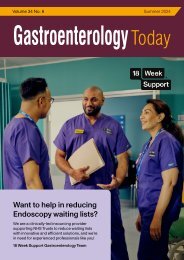Gastroenterology Today Summer 2021
Gastroenterology Today Summer 2021
Gastroenterology Today Summer 2021
Create successful ePaper yourself
Turn your PDF publications into a flip-book with our unique Google optimized e-Paper software.
NEWS<br />
addition, we host a dedicated network section<br />
for registered healthcare professionals from<br />
around the world, allowing them to exchange<br />
advice, research and support on treating these<br />
unpleasant and life changing conditions.’<br />
‘EoE is a chronic disease that, if left untreated,<br />
can cause a severe food obstruction requiring<br />
emergency medical removal. If you are having<br />
the symptoms, we describe on our website<br />
then you should discuss them with your GP<br />
without delay.’<br />
‘In the meantime, vital research continues into<br />
the rarer, more complex lower gut eosinophilic<br />
diseases which are severely life impacting,<br />
an area where currently patients remain<br />
desperate for emerging clinical guidelines and<br />
treatments.’ 6<br />
For more information or to interview<br />
Amanda Cordell, please contact Graeme<br />
Whitcroft at Healthy PR on 07793980500 or<br />
GraemeWhitcroft@healthypr.co.uk<br />
About the EoS network charity<br />
The EoS Network works to ensure that every<br />
person with an Eosinophilic Gastrointestinal<br />
Disease receives a prompt accurate diagnosis,<br />
the right treatment for them and support<br />
to live with their condition. Its vision is for a<br />
world where everyone with an Eosinophilic<br />
Gastrointestinal Disease can eat without pain.<br />
The EoS Network provides information and<br />
support for patients and their families, a<br />
global platform for clinicians and researchers,<br />
educational resources and events and works<br />
with medical bodies, manufacturers and<br />
funders to ensure that the patient’s voice is<br />
heard.<br />
Notes on EoE<br />
EoE is clinically characterized by oesophageal<br />
dysfunction and histologically characterized by<br />
an eosinophil-rich inflammation, most probably<br />
caused by common food allergies or other<br />
environmental triggers. Often misdiagnosed as<br />
GORD, 2 adult symptoms include dysphagia,<br />
bolus obstruction and chest pain related<br />
to swallowing, heartburn and regurgitation.<br />
In children they can include reflux-related<br />
symptoms, nausea, vomiting, abdominal pain,<br />
refusal to eat or failure to grow. 2 Untreated<br />
EoE can lead to oesophageal remodelling<br />
including the formation of strictures and EoE is<br />
the cause of more than 50% of all emergency<br />
presentations for oesophageal food bolus Current clinical guidelines can be found @<br />
impactions. 1<br />
https://www.eosnetwork.org/medicalguidelines<br />
Annual incidence rates of EoE in western<br />
countries are 10 per 100,000 with prevalence References<br />
rates of 86 per 100,000. 4 However, for patients<br />
with oesophageal symptoms who undergo 1. Prevalence of eosinophilic oesophagitis in<br />
gastroscopy the prevalence is 7% whilst in<br />
adults presenting with oesophageal food<br />
patients with dysphagia and bolus obstruction, bolus obstruction. World J Gastrointest<br />
prevalence increases to 23-50%. 1 Many<br />
Pharmacol Ther 2015;6:244–247.<br />
patients have a history of atopy, particularly Heerasing N, Lee SY, Alexander S, et al<br />
asthma, allergic rhinitis and eczema. 5<br />
2. Eosinophilic esophagitis N Engl J Med.<br />
2015;373(17):1640–8. Furuta GT, Katzka<br />
EoE only received classification in the 1990s DA.<br />
and disease awareness, amongst both<br />
3. Gastrointest Pharmacol Ther 2016; 7(2):<br />
clinicians and the general public, is thought to 207-13. Ahmed M. World J<br />
be low. Currently, average time to diagnosis 4. Limketkai BN et al Gut 2019 ; 68 : 2152-<br />
is up to 8.1 years. 2 Due to the patchy nature 2160<br />
of the disease, diagnosis requires 6 biopsies 5. Aliment Pharmacol Ther 2016; 43(1): 3-15.<br />
to be taken from around the oesophagus<br />
Arias Á et al<br />
via endoscopy. Diagnosis is defined by 6. Eosinophilic gastrointestinal diseases<br />
histological presence of eosinophils ≥15hpf. below the belt https://doi.org/10.1016/j.<br />
jaci.2019.10.013 https://www.jacionline.<br />
Treatment for EoE is focused around three<br />
org/article/S0091-6749(19)31367-3/pdf<br />
areas: dietary exclusion, drugs and dilatation. Pesek RD Rothernberg ME<br />
Dietary exclusion is generally considered hard<br />
to maintain and costly. Dilatation, ScheBo_Gastro<strong>Today</strong>_Aug_2020 carried out Registered Multi-Ad_Address_Change<br />
Charity 1143267<br />
when the disease<br />
has progressed<br />
to oesophageal<br />
strictures, is an<br />
invasive procedure<br />
which manages the<br />
symptoms but not<br />
the cause of EoE<br />
and often has to be<br />
repeated.<br />
Until recently, all<br />
drug treatments<br />
were off-label and<br />
topical steroid<br />
therapy was not<br />
optimised for delivery<br />
to the oesophagus.<br />
However, NICE<br />
and the SMC have<br />
now recommended<br />
budesonide<br />
orodispersible tablet<br />
(Jorveza ®) for<br />
active EoE in adults,<br />
a treatment option<br />
designed to reach the<br />
area of inflammation<br />
in the oesophagus<br />
(final NICE guidance<br />
due 23rdJune).<br />
GASTROENTEROLOGY TODAY - SUMMER <strong>2021</strong><br />
29

















